《通信原理实验》课程电子教案(PPT讲稿)MATLAB与通信仿真(英文)Chapter 6 Binary Modulated Bandpass Signaling(2/3)
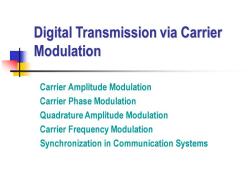
Digital Transmission via Carrier Modulation Carrier Amplitude Modulation Carrier Phase Modulation Quadrature Amplitude Modulation Carrier Frequency Modulation Synchronization in Communication Systems
Digital Transmission via Carrier Modulation Carrier Amplitude Modulation Carrier Phase Modulation Quadrature Amplitude Modulation Carrier Frequency Modulation Synchronization in Communication Systems

Preview We considered the transmission of digital information through baseband channels ■Chapter4and5 However,most communication channels are bandpass channel Remember "Why modulation is needed
Preview ◼ We considered the transmission of digital information through baseband channels ◼ Chapter 4 and 5 ◼ However, most communication channels are bandpass channel ◼ Remember “Why modulation is needed

Carrier Amplitude Modulation PAM signal in baseband Sm(t))=Am8gr(t) Pulse whose shape determines the spectral characteristics of transmitted signal IG(012 Amplitude of mth waveform An=(2m-1-M)d,m=1,2,M 2d:Euclidean distance -W 0 W
Carrier Amplitude Modulation ◼ PAM signal in baseband ◼ ( ) ( ) m m T s t A g t = Pulse whose shape determines the spectral characteristics of transmitted signal -W 0 W |GT(f)|2 Amplitude of mth waveform 2d: Euclidean distance (2 1 ) , 1, 2,., A m M d m M m = − − =
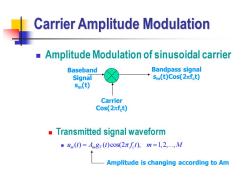
Carrier Amplitude Modulation Amplitude Modulation of sinusoidal carrier Baseband Bandpass signal Signal sm(t)Cos(2πft) Sm(t) Carrier Cos(2πft) Transmitted signal waveform ■4m(t)=An8r(t)c0s(2πft),m=1,2,M Amplitude is changing according to Am
Carrier Amplitude Modulation ◼ Amplitude Modulation of sinusoidal carrier ◼ Transmitted signal waveform ◼ Baseband Signal sm(t) Carrier Cos(2fc t) Bandpass signal sm(t)Cos(2fc t) ( ) ( )cos(2 ), 1, 2,., u t A g t f t m M m m T c = = Amplitude is changing according to Am
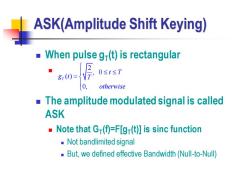
ASK(Amplitude Shift Keying) When pulse g-(t)is rectangular ,0≤t≤T 0, otherwise The amplitude modulated signal is called ASK Note that G(f)=F[g(t)]is sinc function Not bandlimited signal But,we defined effective Bandwidth(Null-to-Null)
ASK(Amplitude Shift Keying) ◼ When pulse gT (t) is rectangular ◼ ◼ The amplitude modulated signal is called ASK ◼ Note that GT (f)=F[gT (t)] is sinc function ◼ Not bandlimited signal ◼ But, we defined effective Bandwidth (Null-to-Null) 2 , 0 ( ) 0, T t T g t T otherwise =
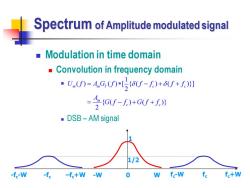
Spectrum of Amplitude modulated signal Modulation in time domain Convolution in frequency domain ·U)=A.G,()*5f-f)+f+f)川 -=GU-f0+6U+f》 DSB-AM signal 1/2 -fc-W -fc -fc+W -W W f-W f+W
Spectrum of Amplitude modulated signal ◼ Modulation in time domain ◼ Convolution in frequency domain ◼ ◼ DSB – AM signal 1 ( ) ( ) [ { ( ) ( )}] 2 { ( ) ( )} 2 m m T c c m c c U f A G f f f f f A G f f G f f = − + + = − + + -W 0 W 1 1/2 -fc-W -fc –fc+W fc-W fc fc+W
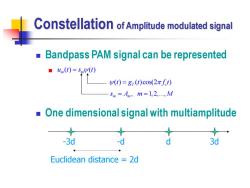
Constellation of Amplitude modulated signal Bandpass PAM signal can be represented w(t)=gr(t)cos(2zft) Sm=Am:m=1,2,.,M One dimensional signal with multiamplitude -3d -d d 3d Euclidean distance 2d
Constellation of Amplitude modulated signal ◼ Bandpass PAM signal can be represented ◼ ◼ One dimensional signal with multiamplitude ( ) ( ) u t s t m m = ( ) ( )cos(2 ) T c t g t f t = , 1, 2,., m m s A m M = = -3d -d d 3d Euclidean distance = 2d
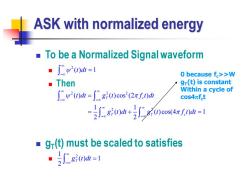
ASK with normalized energy To be a Normalized Signal waveform ■r2o)dh=1 0 because f>>W Then gr(t)is constant Within a cycle of [yr2(0di=∫g20cos(2πf0d cos4元ft d+cos(4d=1 g(t)must be scaled to satisfies g0h=1
ASK with normalized energy ◼ To be a Normalized Signal waveform ◼ ◼ Then ◼ gT (t) must be scaled to satisfies ◼ 2 ( ) 1 t dt − = 2 2 2 2 2 ( ) ( ) cos (2 ) 1 1 ( ) ( ) cos(4 ) 1 2 2 T c T T c t dt g t f t dt g t dt g t f t dt − − − − = = + = 0 because fc>>W gT(t) is constant Within a cycle of cos4fc t 1 2 ( ) 1 2 g t dt T − =
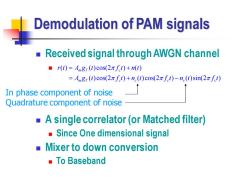
Demodulation of PAM signals Received signal through AWGN channel ■r(t)=Amg(t)cos(2πft)+(t) =Am8r(t)cos(2πft)+n.(t)cos(2πft)-n,(t)sin(2πft) In phase component of noise Quadrature component of noise A single correlator(or Matched filter) Since One dimensional signal Mixer to down conversion To Baseband
Demodulation of PAM signals ◼ Received signal through AWGN channel ◼ ◼ A single correlator (or Matched filter) ◼ Since One dimensional signal ◼ Mixer to down conversion ◼ To Baseband ( ) ( ) cos(2 ) ( ) ( ) cos(2 ) ( ) cos(2 ) ( ) sin(2 ) m T c m T c c c s c r t A g t f t n t A g t f t n t f t n t f t = + = + − In phase component of noise Quadrature component of noise
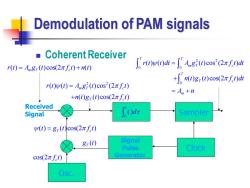
Demodulation of PAM signals ■Coherent Receiver r(t)=Agr(t)cos(2nft)+n(t) 心r0w0h=J4g0cos'(2πf0h +n0)g(0cos2πf10d r(t)w(t)=A.8(t)cos2(2zft) =Am+n +n(t)g(t)cos(2nft) Received Signal Sampler w(t)=8(t)cos(2πft) 8r(1) Signal Pulse Clock cos(2πft) Generator Osc
Demodulation of PAM signals ◼ Coherent Receiver 0 ( ) t d Osc. Signal Pulse Generator Sampler Clock Received Signal ( ) ( )cos(2 ) ( ) m T c r t A g t f t n t = + cos(2 ) c f t ( ) g t T ( ) ( )cos(2 ) T c t g t f t = 2 2 ( ) ( ) ( ) cos (2 ) ( ) ( ) cos(2 ) m T c T c r t t A g t f t n t g t f t = + 2 2 0 0 0 ( ) ( ) ( ) cos (2 ) ( ) ( ) cos(2 ) T T m T c T T c m r t t dt A g t f t dt n t g t f t dt A n = + = +
按次数下载不扣除下载券;
注册用户24小时内重复下载只扣除一次;
顺序:VIP每日次数-->可用次数-->下载券;
- 《通信原理实验》课程电子教案(PPT讲稿)MATLAB与通信仿真(英文)Chapter 6 Binary Modulated Bandpass Signaling(1/3).ppt
- 《通信原理实验》课程电子教案(PPT讲稿)MATLAB与通信仿真(英文)Chapter 5Digital Transmission Through Bandlimited Channels.ppt
- 《通信原理实验》课程电子教案(PPT讲稿)MATLAB与通信仿真(英文)Chapter 4 Baseband Digital Transmission(Multidimensional Signals).ppt
- 《通信原理实验》课程电子教案(PPT讲稿)MATLAB与通信仿真(英文)Chapter 4 Baseband Digital Transmission(Multiamplitude Signal Transmission).ppt
- 《通信原理实验》课程电子教案(PPT讲稿)MATLAB与通信仿真(英文)Chapter 4 Baseband Digital Transmission(Binary Signal Transmission).ppt
- 《通信原理实验》课程电子教案(PPT讲稿)MATLAB与通信仿真(英文)Chapter 3 Analog-to-Digital Conversion(Pulse Amplitude Modulation、Pulse Code Modulation).ppt
- 《通信原理实验》课程电子教案(PPT讲稿)MATLAB与通信仿真(英文)Chapter 3 Analog-to-Digital Conversion(Preview、Measure of Information、Quantization).ppt
- 《通信原理实验》课程电子教案(PPT讲稿)MATLAB与通信仿真(英文)Chapter 2 Transmitters and Receivers.ppt
- 《通信原理实验》课程电子教案(PPT讲稿)MATLAB与通信仿真(英文)Chapter 2 Analog Modulation(Frequency Modulation、Phase Modulation).ppt
- 《通信原理实验》课程电子教案(讲稿)MATLAB与通信仿真(英文)Chapter 7 Spread Spectrum Communication Systems.doc
- 《通信原理实验》课程电子教案(PPT讲稿)MATLAB与通信仿真(英文)Chapter 2 Analog Modulation(SSB – AM).ppt
- 《通信原理实验》课程电子教案(PPT讲稿)MATLAB与通信仿真(英文)Chapter 2 Analog Modulation(Conventional AM).ppt
- 《通信原理实验》课程电子教案(PPT讲稿)MATLAB与通信仿真(英文)Chapter 2 Analog Modulation(AM,Amplitude Modulation).ppt
- 《通信原理实验》课程电子教案(讲稿)MATLAB与通信仿真(英文)Chapter 1 Basic Matlab.doc
- 《通信原理实验》课程电子教案(PPT讲稿)MATLAB与通信仿真电子教案_第1章 matlab基础知识.ppt
- 《通信原理实验》课程电子教案(PPT讲稿)MATLAB与通信仿真电子教案_第3章 图形处理与simulink仿真.ppt
- 《通信原理实验》课程电子教案(PPT讲稿)MATLAB与通信仿真电子教案_第2章 matlab语言入门.ppt
- 《通信原理实验》课程电子教案(PPT讲稿)MATLAB与通信仿真电子教案_matlab在通信中的应用(模拟调制系统).ppt
- 《通信原理实验》课程电子教案(PPT讲稿)MATLAB与通信仿真电子教案_matlab在通信中的应用(模拟信号的数字传输).ppt
- 《通信原理实验》课程电子教案(PPT讲稿)MATLAB与通信仿真电子教案_matlab在通信中的应用(二进制基带系统).ppt
- 《通信原理实验》课程电子教案(PPT讲稿)MATLAB与通信仿真(英文)Chapter 6 Binary Modulated Bandpass Signaling(3/3).ppt
- 《通信原理实验》课程电子教案(PPT讲稿)Verilog HDL数字系统设计与综合实验——第01讲 HDL语言概述.ppt
- 《通信原理实验》课程电子教案(PPT讲稿)Verilog HDL数字系统设计与综合实验——第02讲 Verilog HDL语言基础.ppt
- 《通信原理实验》课程电子教案(PPT讲稿)Verilog HDL数字系统设计与综合实验——第03讲 门级与结构建模.ppt
- 《通信原理实验》课程电子教案(PPT讲稿)Verilog HDL数字系统设计与综合实验——第04讲 数据流建模.ppt
- 《通信原理实验》课程电子教案(PPT讲稿)Verilog HDL数字系统设计与综合实验——第05讲 行为建模(1/2).ppt
- 《通信原理实验》课程电子教案(PPT讲稿)Verilog HDL数字系统设计与综合实验——第06讲 行为建模(2/2).ppt
- 《通信原理实验》课程电子教案(PPT讲稿)Verilog HDL数字系统设计与综合实验——第07讲 综合建模与仿真.ppt
- 《通信原理实验》课程电子教案(PPT讲稿)Verilog HDL数字系统设计与综合实验——第08讲 可综合设计.ppt
- 《通信原理实验》课程电子教案(PPT讲稿)嵌入式系统设计实验——第1章 嵌入式系统概述.ppt
- 《通信原理实验》课程电子教案(PPT讲稿)嵌入式系统设计实验——第2章 嵌入式系统工程设计.ppt
- 《通信原理实验》课程电子教案(PPT讲稿)嵌入式系统设计实验——第3章 ARM7体系结构(1/2).ppt
- 《通信原理实验》课程电子教案(PPT讲稿)嵌入式系统设计实验——第3章 ARM7体系结构(2/2).ppt
- 《通信原理实验》课程电子教案(PPT讲稿)嵌入式系统设计实验——第4章 ARM7TDMI(-S)指令系统.ppt
- 《通信原理实验》课程电子教案(PPT讲稿)嵌入式系统设计实验——第5章 LPC2000系列ARM(1/4).ppt
- 《通信原理实验》课程电子教案(PPT讲稿)嵌入式系统设计实验——第5章 LPC2000系列ARM(2/4).ppt
- 《通信原理实验》课程电子教案(PPT讲稿)嵌入式系统设计实验——第5章 LPC2000系列ARM(3/4).ppt
- 《通信原理实验》课程电子教案(PPT讲稿)嵌入式系统设计实验——第5章 LPC2000系列ARM(4/4).ppt
- 《通信原理实验》课程电子教案(PPT讲稿)嵌入式系统设计实验——第6章 最小系统、片内外设、总线接口、其它外设.ppt
- 《通信原理实验》课程电子教案(PPT讲稿)嵌入式系统设计实验——第7章 μC/OS-II简介、移植规划、移植μC/OS-II、移植代码应用到LPC2000.ppt
